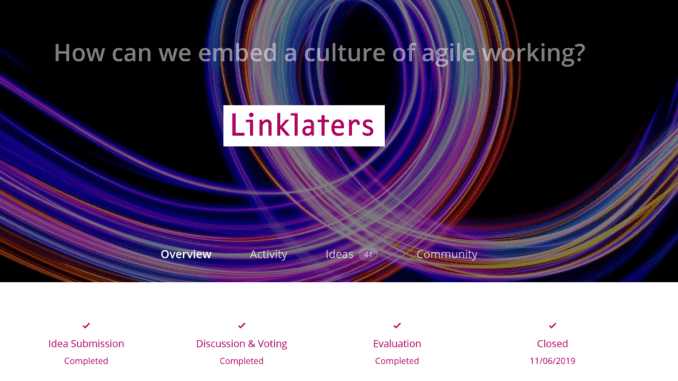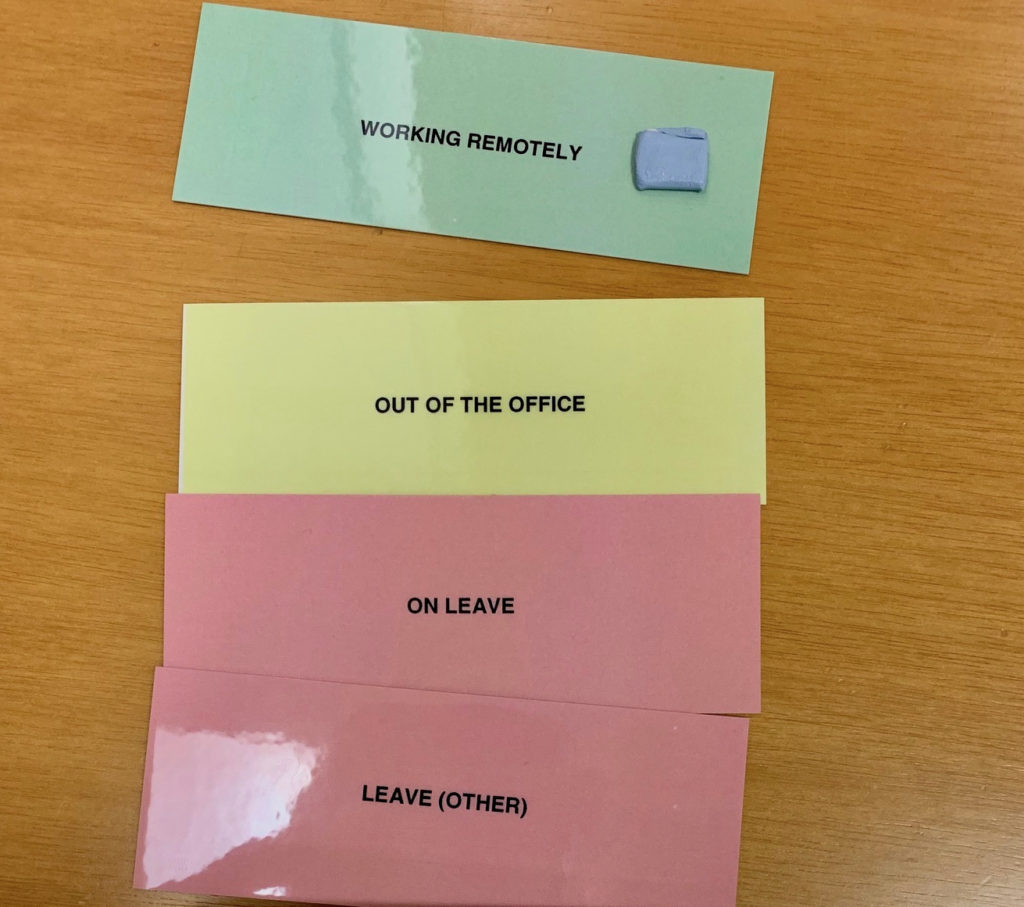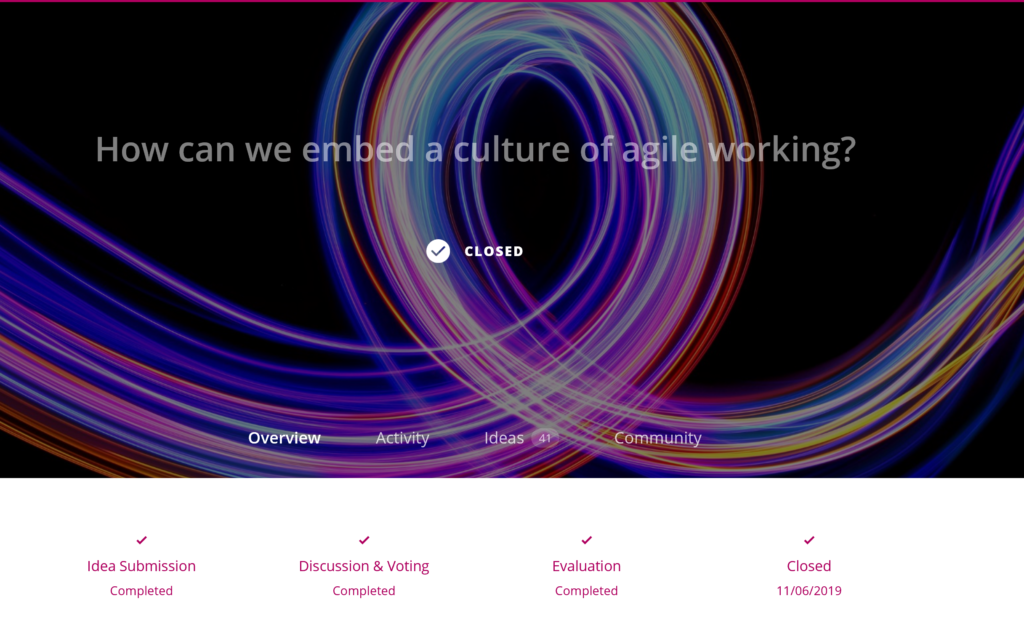
By Irene Madongo, News Reporter
Linklaters’ Ideas Pathway scheme aimed at encouraging staff to come up with fresh ways to improve their work life and client service has generated scores of ideas, with almost 40 implemented or near completion so far, six months after the project was launched.
The crowdsourced ideas have ranged from ways to improve agile working, to the design of document tools. The scheme launched in January this year and already 38 ideas have been implemented, or are in the proof of concept stage, while a further 17 new ideas are being actively evaluated, said the firm.
Speaking to Artificial Lawyer, Shilpa Bhandarkar, Head of Innovation at Linklaters, said that within just a few days of launching the project dozens of ideas had been suggested across the firm, and from multiple offices. For example, in Singapore colleagues conjured up 40 ideas in five days.
She explained that the Ideas Pathway has three general channels: People, Process and Tech.
‘[These] are open to all of our people, whatever their role, wherever they are based. The channels are accessible on any Linklaters device, including our mobiles. The content of those channels (including status of ideas) is open to anyone in the firm to search, comment on, or share. All this speaks to the transparency built into the process and the platform,’ Bhandarkar explained.
‘The Ideas Pathway is designed to work like a social media platform where you can like ideas, and comment. Posts or ideas with lots of likes or comments, for example, can help us to decide which ones we can triage. Take email for example, people predicted it would be phased out, but it’s still here. We ask ‘is there better etiquette around cc and bcc?’ There’s a lot of behavioural, cultural things that affect the way that we work,’ she added.
Campaigns can also be targeted to specific audiences, so the firm can limit participation by role or geography or practice group, or any combination of the above.
By way of example, Bhandarkar noted a couple of ideas they have implemented: ‘People send documents which have comments in bubbles. The problem here is that they don’t come up in [firm] searches. Now we have made them come up as footnotes.’
‘We are also encouraging people to do agile working. One of the ideas is to put up signs outside your office door stating your availability for example – ‘In meetings’, ‘Working from home’ or ‘On holiday’.’

‘At first, these were all in one colour, but then one group took all these signs and colour-coded them, so that when you walk down the corridor you now know just by the colours i.e. green is for ‘Inside,’ and orange for ‘In meetings’, in which case you can then drop them an email,’ she added.

Is this all about the latest technology? No. Sometimes it’s just practical steps that can add a real benefit to the working life of this global firm’s staff. At the same time, Linklaters is as focused on the cutting edge of new technology as other leading firms, as seen with its flagship technology and AI platform, Nakhoda. This goes to show that there is a spectrum of ways to innovate, and perhaps a law firm needs them all.
Looking ahead, the future looks bright for the crowdsourcing ideas project, which now has plans to expand the areas it engages with.
‘In September we are also running a legal design channel, which will be about bringing the best legal design ideas to our clients,’ Bhandarkar concluded.
—
Four examples from Linklaters’ Ideas Pathway:
- Example of a working practice change from the Singapore agile working campaign: Using the custom status in Jabber (our IM tool) to show availability.
‘People might find it helpful to utilise this function to create an ‘Available – working from home’ option, which they could select as and when needed. Alternatively, you could permanently set an option which shows regular WFH (Working From Home) arrangements, e.g. ‘Available – WFH on Mondays’.
This could be another way for people to communicate their location or raise awareness of regular agile working arrangements – particularly for others also working out of the office (who can’t spot that helpful sign you may have left on your desk!)’
- Another practical idea from the Singapore agile working campaign: recognising that one of the obstacles to agile working is equipment and could the firm facilitate the set-up of home offices?
‘Specifically, could the firm facilitate the set-up of home offices by organising group purchases of equipment that we will need (e.g. monitors, docking stations)?
This is of course premised on the assumption that we would be able to obtain better prices for IT equipment for group purchases than our people could negotiate individually. We would also be able to suggest our recommended (for example) docking stations rather than leaving it to our people to have to do that research themselves.’
- Agile working signs (linked to example above):
‘Colour coding means that you can walk down a corridor and without even having to read what is on the sign, get a sense of someone’s availability based on whether the sign is red, yellow or green. Even our senior management now use these badges (which you stick on your door with BlueTac as required).’
- Converting comment ‘bubbles’ in Word into footnotes.
‘Comment bubbles are notoriously problematic as they don’t show up in the default Microsoft Word settings, and it’s quite difficult to print a document with all of them showing correctly at the side of the page. It also shrinks the text on the rest of the page. Footnotes however print automatically and mean that the comment is still on the same page as the content to which it relates.
On documents that run into the hundreds of pages, this can be a really helpful, time saving tool that also reduces risk.
This idea was originally suggested by an associate in our Projects practice, Isabella Peplinski, (who is also a member of our Projects Innovation team). The Word macro solution has now been rolled out globally, given its universal use and appeal.’